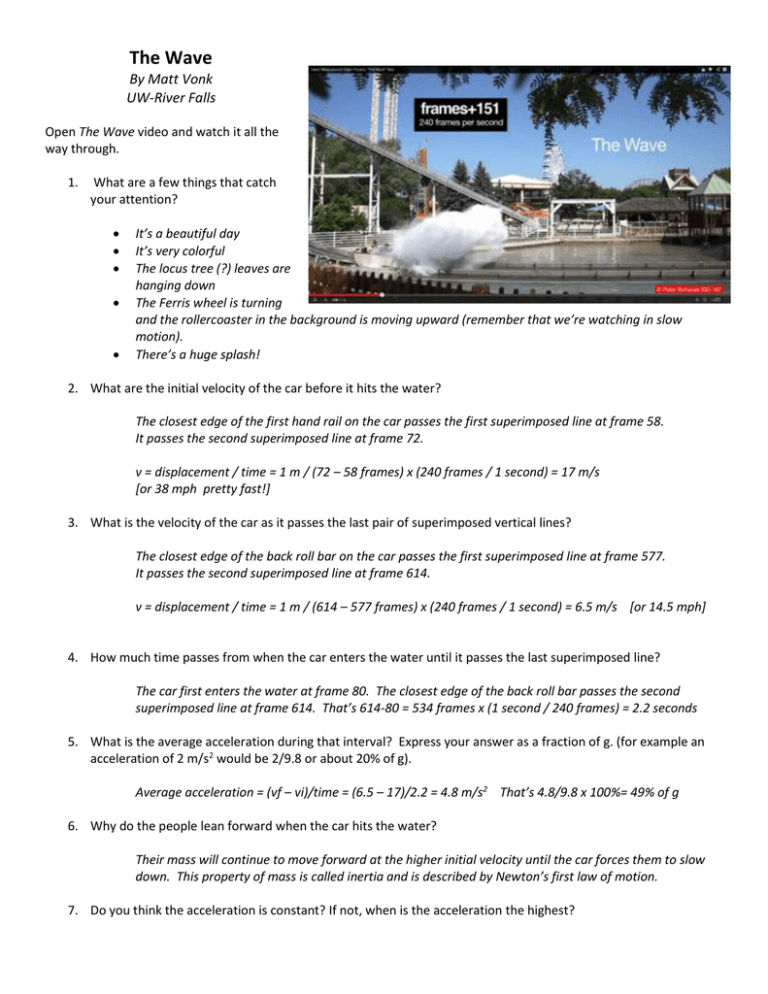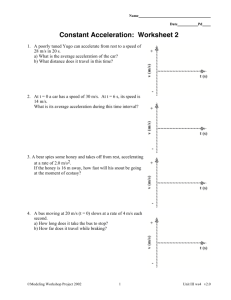The Wave Worksheet solutions
advertisement

The Wave By Matt Vonk UW-River Falls Open The Wave video and watch it all the way through. 1. What are a few things that catch your attention? It’s a beautiful day It’s very colorful The locus tree (?) leaves are hanging down The Ferris wheel is turning and the rollercoaster in the background is moving upward (remember that we’re watching in slow motion). There’s a huge splash! 2. What are the initial velocity of the car before it hits the water? The closest edge of the first hand rail on the car passes the first superimposed line at frame 58. It passes the second superimposed line at frame 72. v = displacement / time = 1 m / (72 – 58 frames) x (240 frames / 1 second) = 17 m/s [or 38 mph pretty fast!] 3. What is the velocity of the car as it passes the last pair of superimposed vertical lines? The closest edge of the back roll bar on the car passes the first superimposed line at frame 577. It passes the second superimposed line at frame 614. v = displacement / time = 1 m / (614 – 577 frames) x (240 frames / 1 second) = 6.5 m/s [or 14.5 mph] 4. How much time passes from when the car enters the water until it passes the last superimposed line? The car first enters the water at frame 80. The closest edge of the back roll bar passes the second superimposed line at frame 614. That’s 614-80 = 534 frames x (1 second / 240 frames) = 2.2 seconds 5. What is the average acceleration during that interval? Express your answer as a fraction of g. (for example an acceleration of 2 m/s2 would be 2/9.8 or about 20% of g). Average acceleration = (vf – vi)/time = (6.5 – 17)/2.2 = 4.8 m/s2 That’s 4.8/9.8 x 100%= 49% of g 6. Why do the people lean forward when the car hits the water? Their mass will continue to move forward at the higher initial velocity until the car forces them to slow down. This property of mass is called inertia and is described by Newton’s first law of motion. 7. Do you think the acceleration is constant? If not, when is the acceleration the highest? No, I don’t think it’s constant. I think it’s small at the very beginning when the car just starts to enter the water (since the water is shallow). Then as the car enters the deep water I would think the water’s force on it (and therefore its acceleration) would hit a maximum. Then as the car slows down I would think that the acceleration would also decrease. Newton’s third law says that when two objects interact they both experience the same magnitude of force but in opposite directions. 8. Can you point to evidence in the video that indicates that the car feels a force? Yeah, it slows down. 9. Can you point to evidence that the water feels a force, and if so, what is the direction of the force on the water? Yes, the water goes flying off in a huge plume. Something must have forced it to do that. Since the water was at rest and then starts travelling in a direction that is up and to the right the force on it must have been up and to the right. 10. What must be the direction of the force that the water exerts on the car? Newton’s third law says that it must be opposite the direction the car’s force on the water. Therefore the water’s force on the car must be down and to the left. 11. Is the car accelerating in that direction? Why or why not? The car is certainly accelerating in the left direction (it’s slowing down as it moves right which implies that it’s accelerating to the left), but it’s not accelerating downward. That must be because the track is preventing it from doing so. In addition to supporting most of the weight of the car (I assume the water exerts some buoyant force on the car especially as it slows down) the track must exert an upward force in order to counter the downward force that the water exerts on the car. I might have thought that the force of the track on the car would decrease when the car entered the water (since the buoyant force of the water would support some of the weight of the car), but based on my answer to the above question, I now think that the force of the track on the car actually increases when the car enters the water.



